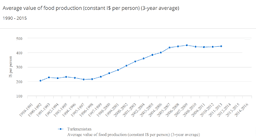ASHGABAT (Trend) — The wheat harvesting started on June 7 in four of five provinces in Turkmenistan. Some 400,000 tons of wheat have been harvested.
Turkmen farmers fulfilled the state order for wheat production by 25% as of June 16, the Turkmen government said. Some 1,600 tons of grain are planned to be collected from a 760,000 hectare area in Turkmenistan this year.
Turkmenistan obtained a special award by the Food and Agriculture Organization (FAO) of the United Nations for the achievements in ensuring food security. FAO interventions and resource mobilization for Turkmenistan envisages three priority areas: Agricultural production and food security, with a view to increasing the contribution of agriculture, forestry and fisheries to the country’s economic growth; Sustainable natural resource management, climate change mitigation and adaptation; Increased resilience of rural livelihoods to agriculture and food security threats and shocks, with a view to increasing capacities for coping with the impacts of drought.
In 2011, the total economically active population was 2.4 mln, or 48% of the total population. The economically active population in agriculture is an estimated 0.7 mln (29% of total active population), of which 53% is female. Practically all the rural population possess irrigated land ranging from 0.01 to 0.25 ha for small-scale agricultural production, mainly fruit, vegetables, beans, berries and for raising cattle and poultry. A considerable proportion of the urban population possesses rural irrigated land of up to 0.01 ha, used to grow agricultural products for their own consumption. During the past years the urban population has tended towards accessing their rural plots to keep cattle and poultry.
In 2004, about 576 large-scale farm associations and 600 other legal entities, took part in large-scale agricultural production. About 6,100 individuals participated in medium-scale production and more than 620,000 families engaged in small-scale agricultural production.
The Government priority is to ensure food self-sufficiency by focussing on key food products. Wheat and rice are the main traditional crops cultivated to ensure food security. These crops are closely correlated to large-scale irrigation schemes. Individual rural entrepreneurs produce 99% of potatoes, 69% of watermelons, 24% of grape production, 82.5% of meat, 96% of milk and 93% of eggs. The population’s food demands are met by large-scale irrigation schemes, small-scale production and imported goods. In 2004, the importation of cattle breeding stock amounted to $55.6 mln, crops to $28 mln and animal and vegetable oils and fats to $13.9 mln.


